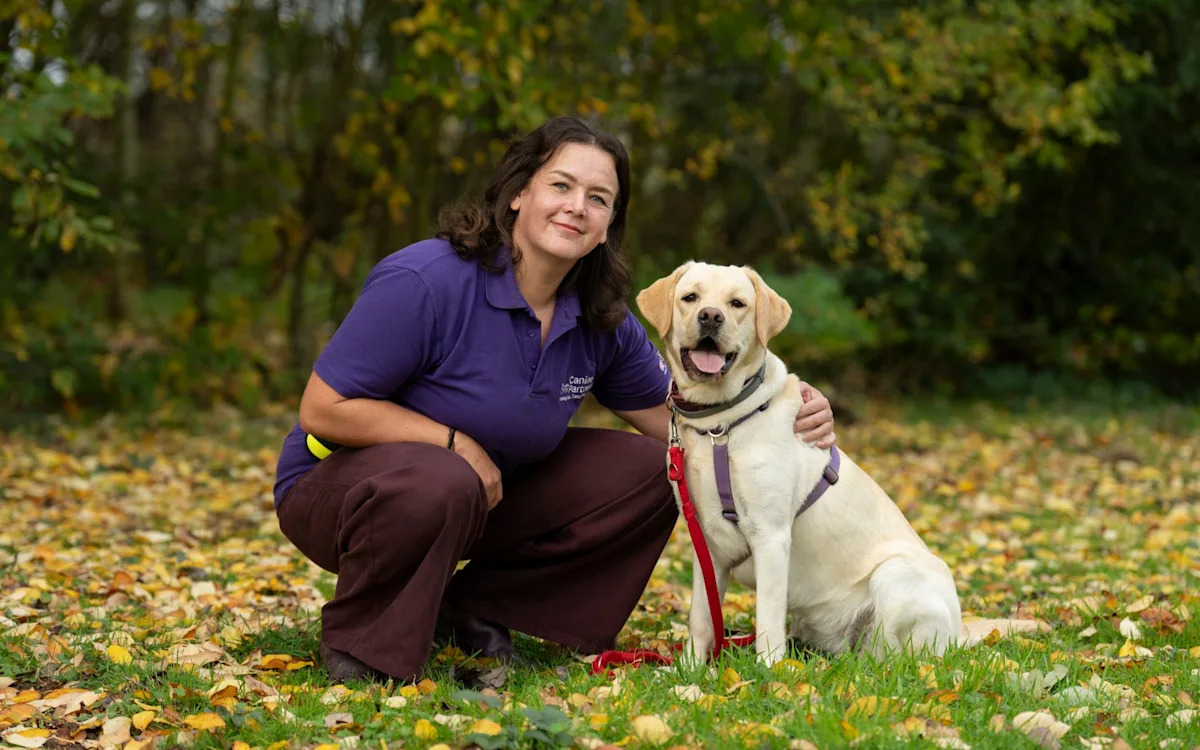Picture a well-behaved dog out for a walk in the park. Imagine him trotting on the path alongside his human even though he’s off-lead. See him sitting calmly and eyeing his ball with patience as he waits for his owner to finish chatting with a friend. And then, finally (finally!) see him seizing his moment to bound after the ball, which he will, of course, retrieve and loop back with to drop at his owner’s feet for another throw.
Unless, that is, my dog gets there first, picks up the ball and bolts in the opposite direction. “No, Taylor! That’s not yours! Drop it! DROP IT!” Sorry, I’ll say, as I trudge toward the now-grumpy owner and hand over the spare ball I carry for this purpose. She’s unlikely to return any time soon. A ball for a ball seems fair. Even if I know there’s little chance of my dog bringing back the ball that she stole.
Since we brought Taylor home as an eight-week-old puppy last August, she’s been the source of endless joy and laughter in my house. An Australian labradoodle, she’s sweet, playful and patient with three kids who vacillate between smothering her with kisses and ignoring her in favour of the TV.

Emily Cronin says of her dog, Taylor: ‘She’s a very good girl. Except when she isn’t’ – Andrew Crowley
She’s a very good girl. Except when she isn’t. When she makes one of her nightly lightning strikes on the dinner table to steal a meatball, for instance. Or, when she runs off during a walk and disappears from view, only for a stranger to call me from three streets away to say she’s found my dog.
This dog looks like a cupcake and behaves like Harry Houdini crossed with a barracuda. We’ve done a bit of training, but Taylor’s energy, curiosity and sheer voracity outmatches me every time. What’s an exasperated dog owner to do?
“Most pet dogs are lovely, but they’ve always got little quirks that might be difficult to deal with,” says Katie Bodsworth. As puppy training co-ordinator with Canine Partners, a registered charity that trains assistance dogs, and which is part of The Telegraph’s 2025 Christmas appeal, she spends most of her time working with puppies being prepared for futures as service dogs.
Still, she’s patient with friends and family who “constantly” ask her for help with basic pet challenges. “Training is pretty much my whole life,” she laughs, then dives into advising me on Taylor.
“The first step is to keep in mind that the relationship with your puppy is absolutely key. Once you understand them, you can give them what they need in an appropriate way, rather than the puppy seeking whatever it wants and potentially causing mischief.”
Back to the park, where Taylor will run off at the drop of a leaf, ball or squirrel, and answer my call for her to “Come!” with a cold-as-ice stare.
Bodsworth begins by asking me a question that would have been less surprising from an acting coach: “What’s her motivation? What do you think she’s achieving or getting when she’s off gallivanting, that she’s not getting when she’s with you?”
She’s getting stimulation and fulfilling her curiosity, I suppose.
“Exactly,” Bodsworth says (you can tell she studied psychology and holds a master’s degree in clinical animal behaviour). At just short of a year and a half old, “she’s also in peak adolescence, so she’s going to be trying to explore her independence.”
My first mistake may have been letting Taylor off the lead too soon and too inattentively. Bodsworth encourages me to use a long lead to keep Taylor closer to hand (“you will get a little bit tangled every now and again”).
Then, instead of unclipping her and setting her loose, I should prime Taylor to return when called via a series of “check-ins”: calling her back before she gets too far away, rewarding her with a high-value treat when she comes (chicken!) and sending her off again.
These recall sequences with intermittent rewards “help form an association that recall means good things are happening, not that we’re going to pop the lead on and go home every time you call her back,” Bodsworth says.

Canine Partners dog trainer Jenna Ellison is seen here teaching Labrador Myrtle to retrieve clothes from a washing machine – Andrew Fox
“If you give her a treat and then say, ‘Off you go!’, that teaches her that being recalled doesn’t mean the fun is ending.
“You want to teach her that being with you on and off, even though she’s off-lead, is the best thing in the world.”
One of the main issues Bodsworth works on with puppies for Canine Partners is dog distraction, also known as going wild with excitement upon seeing other dogs in the park.
Teaching puppies to remain settled throughout the day, stay off furniture (unless invited) and toilet in the garden on cue also come up frequently.
Other than that, she’s making minor course-corrections with puppies who are already expertly trained. “One of the most important things we want our dogs to be is easy to live with. That allows their future partners to focus on getting help from the dog, rather than the other way around.”
What does Bodsworth wish humans knew about encouraging better or more desired behaviour in their pet dogs? “I wish people would realise that their dog is a lot smarter than they give them credit for.
“They have complex emotions, ways of learning, ways of thinking. I always encourage people [who are frustrated] to stop and think, ‘how am I accidentally encouraging this behaviour without meaning to’. They want to get what they want to get.”

Canine Partners trainer Jenna Ellison working with Labrador puppy Penny, who will go on to become an assistance dog – Andrew Fox
In Taylor’s case, what she wants is our dinner. Also breakfast, lunch and snacks (she doesn’t discriminate). During family meals, she puts her paws on the table and makes blink-and-you’ll-miss-it attacks on burgers, pasta, chicken and steaks. We’ve tried everything from feeding her only when we’re ready to sit down (our food is better, apparently) to closing her in another room (she cries; the kids can’t bear it).
She’s smart enough to target the littlest family member first. We call her a table shark, and I don’t know what to do to stop her other than physically hold her back through an entire meal.
“That’s a tough one,” Bodsworth says. “It’s a self-rewarding behaviour, because every time she jumps up, she’s getting something. The more it happens, the more it’s going to happen.”
There’s no easy answer, but Bodsworth recommends mat training. This entails using treats to teach Taylor to stay on a designated blanket or mat for a reasonable interval – initially with no other food in the vicinity.
“The end goal is that we expect her to stay here for the entire meal, until you give her the release cue.”
It’s a slow process. I begin by laying down a folded towel when we’re home alone in the middle of the afternoon, no lasagna in sight. She’s happy to consume all the treats I throw her way, but after several minutes (and more than a dozen treats), I stand to move farther back and she follows me. This could take a while.
“It’s a lot of hard work because you’re dealing with quite a practised behaviour,” Bodsworth agrees. “But it can be done.”
Of course it can – returning other dogs’ balls to their rightful owners, though? I’m pretty sure that’s a hopeless case.
Canine Partners is one of four charities supported by this year’s Telegraph Christmas Charity Appeal. The others are Prostate Cancer Research, Motor Neurone Disease Association, The Not Forgotten. To make a donation, please visit telegraph.co.uk/appeal2025 or call 0151 317 5247
Try full access to The Telegraph free today. Unlock their award-winning website and essential news app, plus useful tools and expert guides for your money, health and holidays.

